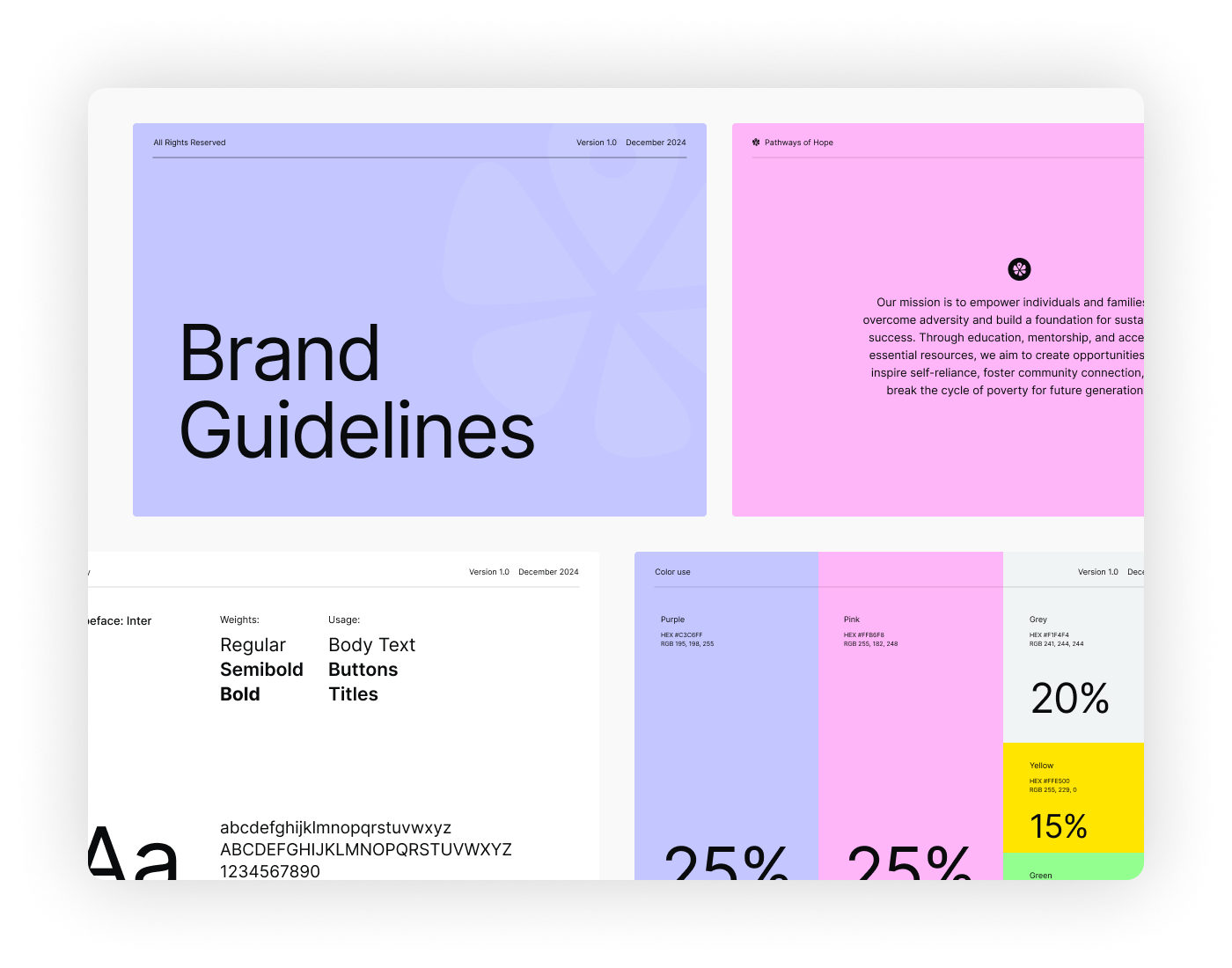Consider your nonprofit like a house. While your beneficiaries are enjoying the house from the inside, your sponsors and partners are helping renovate the house, your marketing/communications team are enhancing the exterior, and the rest of your team is making sure the house is functional and the beneficiaries are uplifted. This is a remarkable group effort, made possible through the combined support of all branches. Arguably, the strongest force in the entire house lies beneath all those helping above ground: your mission statement.
Your mission statement grounds everything in your company: hiring, marketing, workplace culture, event planning, and more. While your staff may continue onto new paths, your mission statement remains. To effectively write a strong mission statement, let’s first reexamine the elements of a mission statement.
Elements of Effective Mission Statements
Effective mission statements:
- Clarify why the nonprofit exists
- Explicitly detail whom it serves
- Iterate how it serves beneficiaries
Besides exuding transparency and purpose, effective mission statements guide decision-making, motivate staff and supporters, and help refocus internal and external energy towards the common goal. Though similar to a vision statement, your mission statement iterates your overall purpose whereas your vision statement details a world in which your nonprofit had reached optimal influence (find out more about vision statements here). With these intentions in mind, it’s time to begin drafting your nonprofit mission statement.
How to start
Before you start jotting down ideas, commit to developing your mission statement within this framework:
Keep it concise
Some of the most effective mission statements are only a few words! No need to overdo it here. A concise mission statement will ensure that it is memorable and powerful to internal and external audiences.
Welcome participation
Back to the house example: your nonprofit operates with the combined efforts of many parties/departments who all understand your nonprofit in varying ways. Include their diverse perspectives in the process.
Include revisions
While it’s important to draft a mission statement designed to “stand the test of time,” be open to amendments and revisions. As your nonprofit evolves, be sure to reevaluate the changes in respect to your mission statement: if the changes are vital to the nonprofit but don’t fit within the language of the mission statement, revise it.
Brainstorming Your Mission Statement: Use Stories
While we’ve created a fun mission statement generator, above, to kick off your brainstorming, there’s nothing quite as powerful as testimonies and stories. The inspiration, passion, and emotion emulated guides constituents to donate and people to volunteer. Harness this power into your mission statement.
Gather a group
This can include staff, sponsors, volunteers, and beneficiaries.
Document their stories
With their consent, record their stories regarding the impact of your nonprofit. Or if you are gathering these digitally, be sure to compile them in the same document for reference.
-
For staff, ask: what does it look like when our nonprofit it succeeding?
-
For sponsors, ask: what motivated you to donate?
-
For volunteers, ask: what motivated you to give your time to us?
-
For beneficiaries, ask: in what ways have you benefited from our services?
While there is no set number of stories you should collect, include at least 5 from each category if you can.
Search for Themes
You have a decent file of stories from diverse people affected by your nonprofit. Now it’s time to code for themes. This activity is typical of qualitative researchers who seek to understand a phenomena as it affects a target audience. It is a highly effective tool in synthesizing, consolidating, and utilizing participant information.
Divvy up the stories between a team
The more eyes reviewing the stories, the better. This will also help optimize the overall process.
Predetermine themes to document
You can advise your team to look specifically for information such as:
- Actions/verbs your nonprofit executes: (i.e. informs, influences, provides, etc).
- People your nonprofit serves: (i.e. target beneficiary information).
- Problems your nonprofit aims to address: (i.e. hunger, poverty, inequality).
The highlighted information categorized within these themes will be crucial for determining the language used for the mission statement.
Determine themes as you all read
If you would rather not predetermine the themes and instead want to determine them as you go, follow this process:
Read 1-3 stories and discuss common trends with the team: what are the common phrases voiced by each party? Which people, places, problems, and actions are mentioned most frequently? After reading a few stories, determine different themes and categorize respondent phrases within these themes. They can include predetermined themes from above as well as:
- Services your nonprofit provides (i.e. education, specific products, etc.)
- Sponsors your nonprofit works with (i.e. major sponsors)
- Movements your nonprofit work towards (i.e. peace, success, equality, etc.)
Begin Drafting
Between all the predetermined and organically developed themes, you should have a list consisting of categories along these lines:
- Actions your nonprofit executes
- People your nonprofit serves
- Problems your nonprofit aims to address
- Services your nonprofit provides
- Movements your nonprofit works towards
These themes and the content within each will help you draft the language to your mission statement.
To begin drafting, consider evaluating and incorporating elements from 2-4 of these themes. For example, take language from theme 1, 3, 5 exclusively to draft the structure of your mission statement.
Recommendations When Drafting
You want your mission statement to be accessible to wider audiences: those who are passionate about your work and those who are unfamiliar with it. For that reason, it is recommended that you draft your mission statement with these diverse audiences in mind. Below are a list of recommendations to consider while drafting:
-
Avoid generalizations: your nonprofit is special! Include language that reflects such.
-
Discard jargon and acronyms: as previously noted, your mission statement should be accessible to greater audiences. Jargon and acronyms make language that much harder to decipher. If people can’t understand your mission, then they can’t participate in your nonprofit! Be sure to exclude these hindrances without generalizing your mission too.
Revising and Testing Your Statement
At this point, you have combined language from 2-4 themes and considered cautions as noted above. You have your mission statement draft, and now it’s time to test it out. But how?
Read it aloud
As a Language Arts teacher, Reading Specialist, and Writing tutor, one of my go-to strategies for editing/revising is to read the piece aloud. Not only can you hear any grammatical errors or areas of influidity, but you can also gauge the ring to the writing. In other words, you can hear how catchy/memorable/powerful it is.
Seek internal and external feedback
Perhaps you’ve been working on this mission statement for months now! It may have a strong “ring” to you, but maybe others don’t see it that way. While you want to take all feedback with a grain of salt, it is important to determine how greater audiences perceive your mission statement draft. Ask those inside and outside the company for this feedback to ensure that your mission statement is as strong as it can be.
Closing Thoughts
The key to a durable house lies in the foundation, and each foundation is designed differently depending on the terrain. If you live in an area that’s prone to earthquakes, floods, or hurricanes, you want to design your foundation accordingly. It sure is easy to look at a sturdy house and want to copy their foundation, but if you exist in a separate terrain, that foundation will not serve your house well. The same goes for your mission statement.You may want to take elements of strong mission statements from other successful nonprofits, but ultimately, you are better off using others’ models for guidance and curating yours specific to your cause. And this is because your nonprofit is unique. And your mission statement should reflect nothing short of this beauty.




